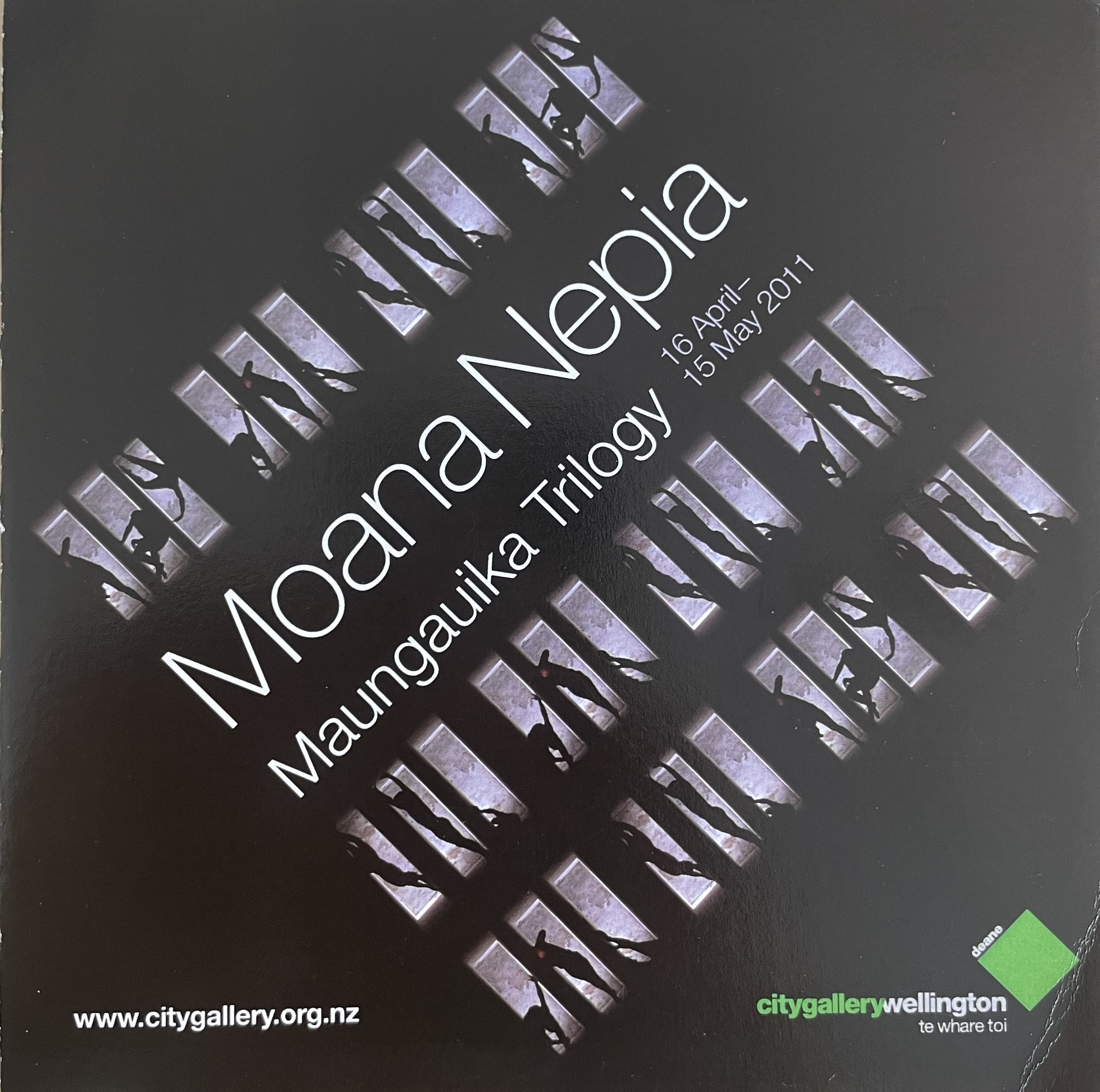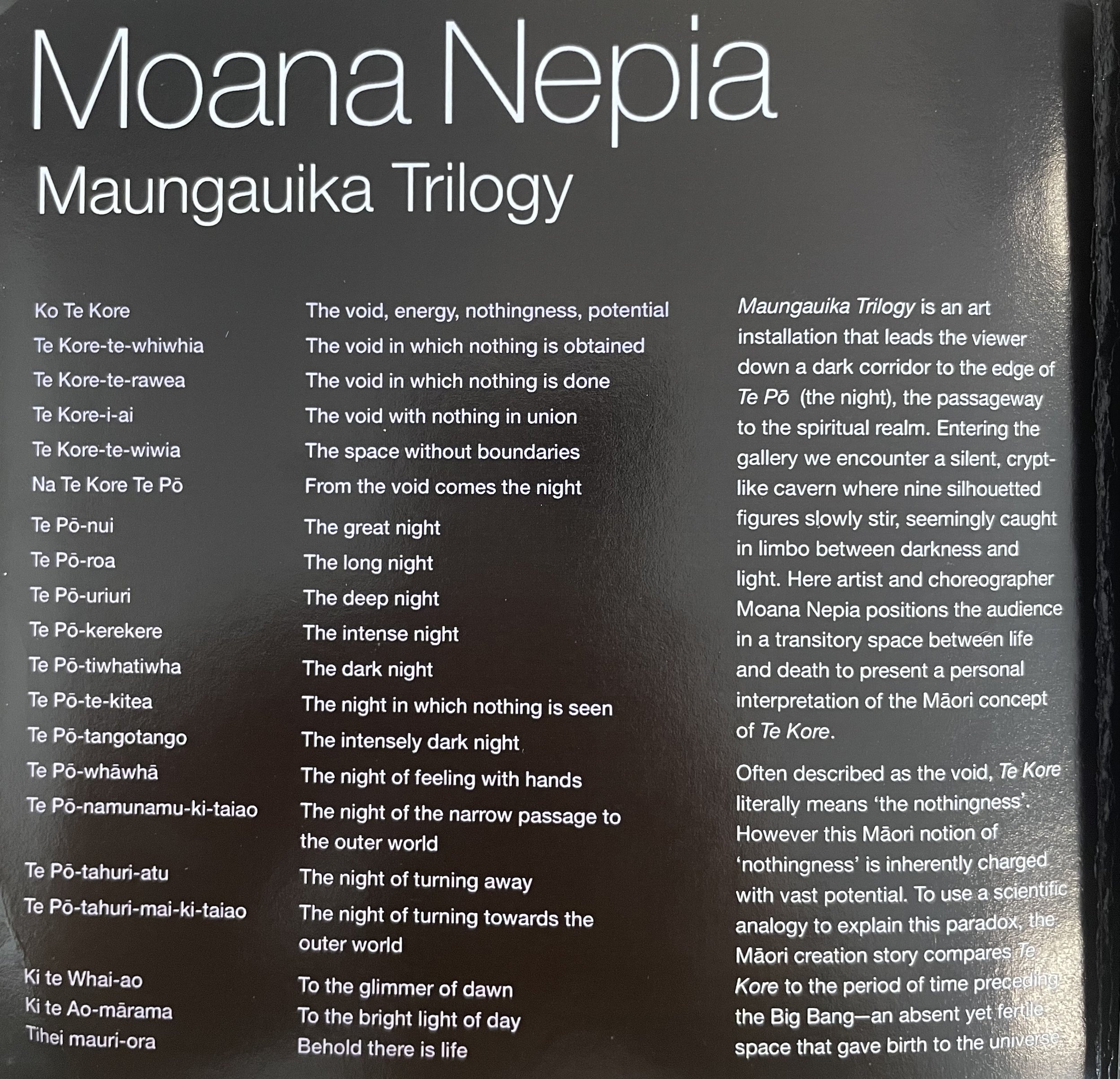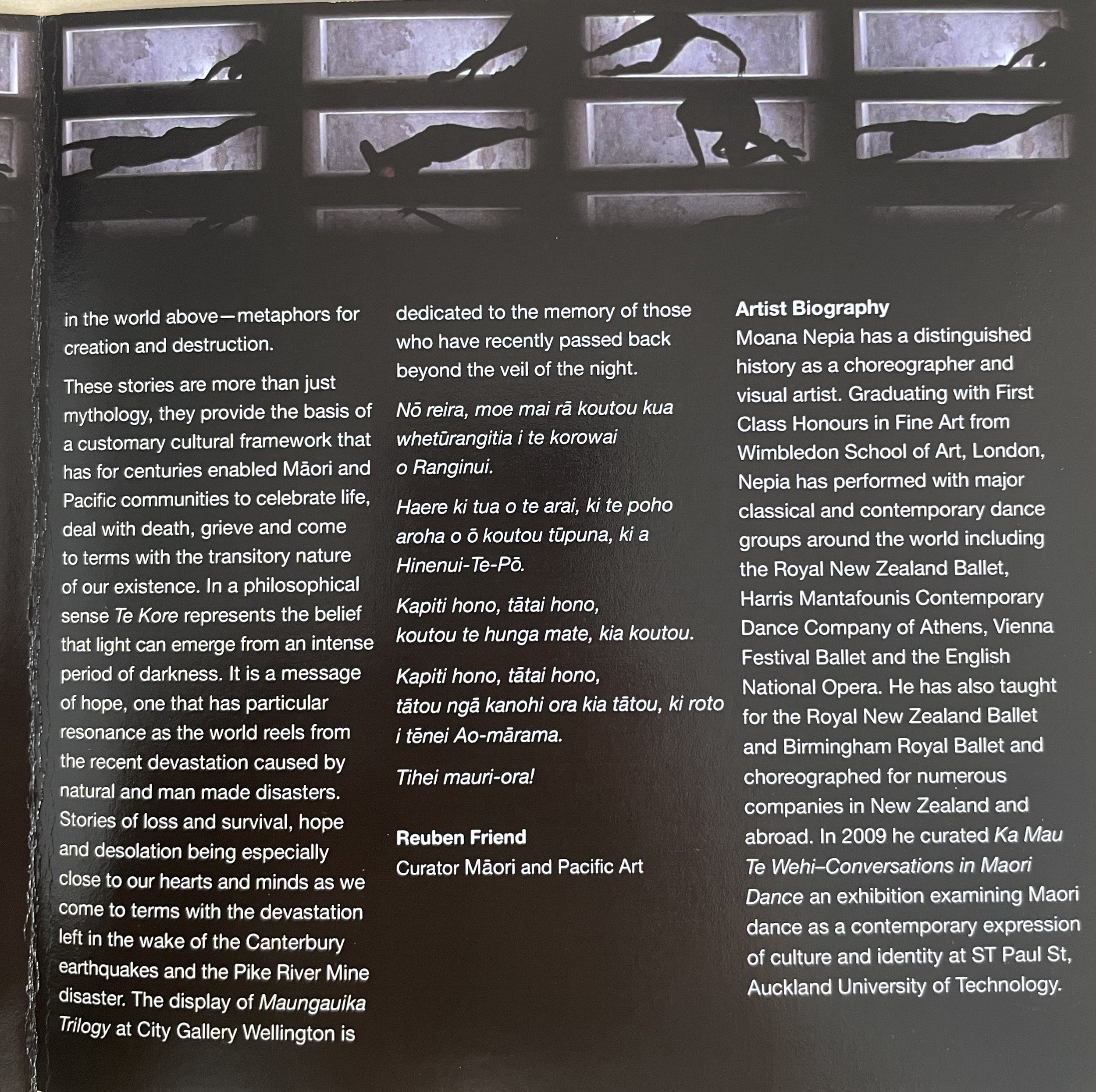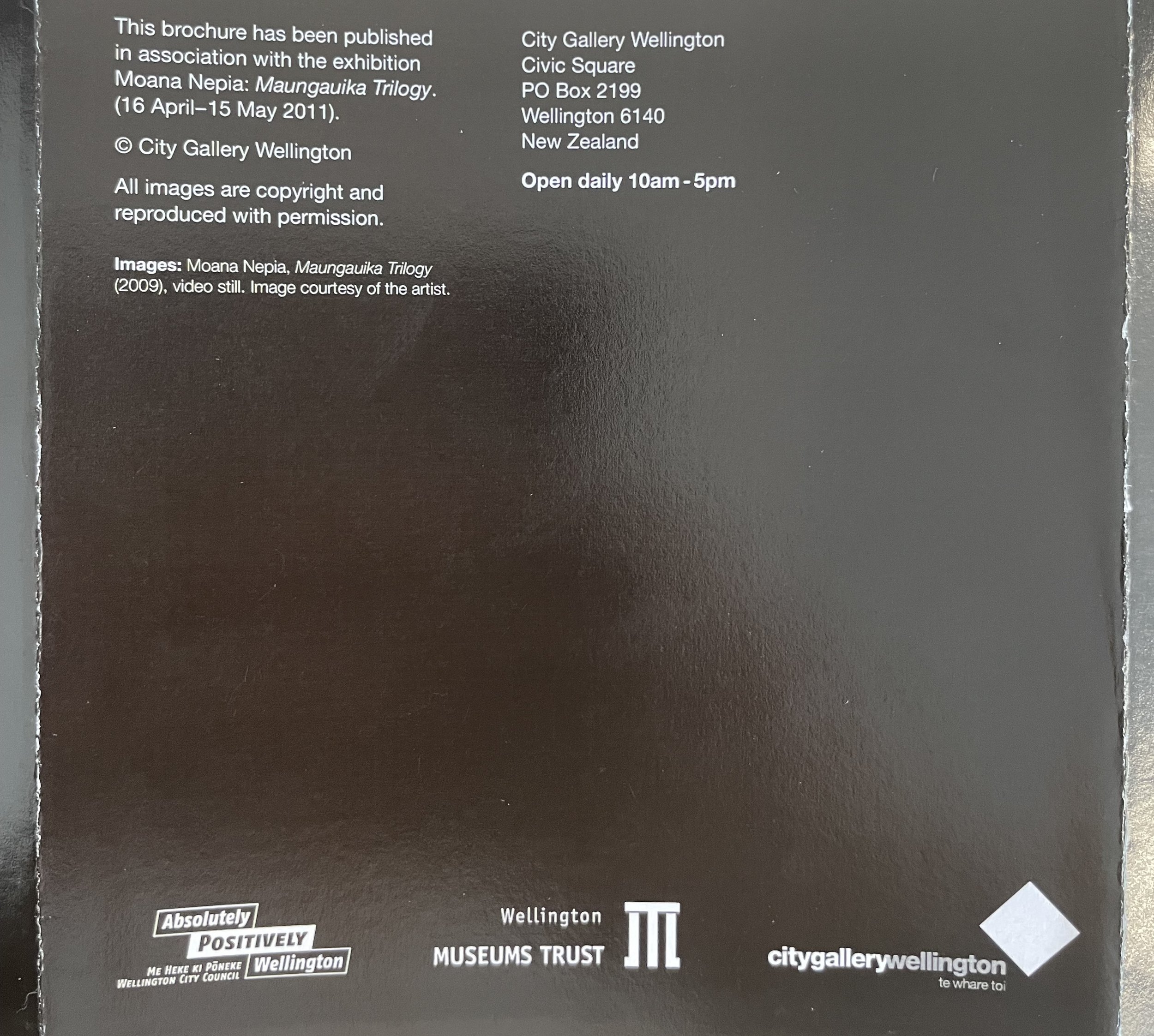Moana Nepia: Maungauika Trilogy
City Gallery Wellington | Te Whare Toi
Deane Gallery: 16 April–15 May 2011
Curated by Reuben Friend
Maungauika Trilogy, a silent video installation by choreographer Moana Nepia, offers an interpretation of the Māori concept of te kore. Te kore literally means ‘the nothingness’. However, this ‘nothingness’ is charged with potential. It can be understood as an incubation space, a nurturing void that enables life to exist where previously there was nothing. Nepia transforms the gallery into a crypt-like space, representing the transition space between life and death. His shadowy figures move slowly, straddling the threshold between night and day. Are they new beings, emerging from the void into the world of light (te ao mārama), or, are they tired souls returning back, beyond the veil of the night, to be embraced by the darkness once more?
Below is a copy of the exhibition catalogue essay that I authored for Maungauika Trilogy.
Moana Nepia: Maungauika Trilogy, moving image installation, in the Deane Gallery, City Gallery Wellington, 2011
Moana Nepia: Maungauika Trilogy
Ko Te Kore
Te Kore-te-whiwhia
Te Kore-te-rawea
Te Kore-i-ai
Te Kore-te-wiwia
Na Te Kore Te Po
Te Po-nui
Te Po-roa
Te Po-uriuri
Te Po-kerekere
Te Po-tiwhatiwha
Te Po-te-kitea
Te Po-tangotango
Te Po-whāwha
Te Po-namunamu-ki-taiao
Te Po-tahuri-atu
Te Po-tahuri-mai-ki-taiao
Ki te Whai-ao
Ki te Ao-marama
Tihei mauri-ora
The void, energy, nothingness, potential
The void in which nothing is obtained
The void in which nothing is done
The void with nothing in union
The space without boundaries
From the void comes the night
The great night
The long night
The deep night
The intense night
The dark night
The night in which nothing is seen
The intensely dark night
The night of feeling with hands
The night of the narrow passage to the outer world
The night of turning away
The night of turning towards the outer world
To the glimmer of dawn
To the bright light of day
Behold there is life
Maungauika Trilogy is an art installation that leads the viewer down a dark corridor to the edge of Te Po (the night), the passageway to the spiritual realm. Entering the gallery we encounter a silent, crypt-like cavern where nine silhouetted figures slowly stir, seemingly caught in limbo between darkness and light. Here artist and choreographer Moana Nepia positions the audience in a transitory space between life and death to present a personal interpretation of the Māori concept of Te Kore.
Often described as the void, Te Kore literally means 'the nothingness". However this Māori notion of 'nothingness' is inherently charged with vast potential. To use a scientific analogy to explain this paradox, the Māori creation story compares Te Kore to the period of time preceding the Big Bang — an absent yet fertile space that gave birth to the universe.
In this analogy, Te Kore is followed by Te Pō (the night), a period of darkness in which the cosmos expanded. Within the dark depths of Te Pō portions of matter began to collide and consolidate forming the building blocks of creation. Reaching critical mass, te Ao-marama (the physical world of light) broke through the veil of darkness bringing with it te Puna-waiora, the life sustaining waters of creation.
Te Kore may also be likened to the womb, and Te Pō the stages of foetal development. Te Puna-waiora here refers to the embryonic fluid that begins to flow as the infant bursts free into te Ao-marama, the world of light. The expression tihei mauri-ora, literally meaning the 'sneeze of life', refers to the first breath a child takes when it is born.
Te Kore can be thought of as an incubator, one that enables life to exist where previously there was 'nothing'. Te Pō is the passageway between the non-physical realm Te Kore and the physical realm of te Ao-marama. In death our wairua (spirit) must find a passageway back to the depths of Te Pō.
One mythological account of the legendary Polynesian demi-god Maui recalls his attempt to return to the spiritual realm of Te Po in order to attain immortality by re-entering the womb of Hinenui-Te-Pō, the personified matron of Te Pō and caretaker of the spiritual realm. Maui however met his fate when a little bird began to laugh at the sight. This awoke Hinenui-Te-Pō who immediately crushed Maui between her legs, forever trapping him in the doorway between realms. Like Maui, the slow moving figures in Nepia's installation appear to straddle a subterranean doorway between worlds.
Here the work leads itself to a reading where it is possible to imagine that these are new beings, still in incubation, waiting to emerge from Te Pō into the world of light. Conversely they could be viewed as tired souls returning back beyond the veil of the night and into the waiting embrace of Hinenui-Te-Pō.
Nepia filmed this performance in the disused military tunnels of Maungauika North Head, the mountain which stands guard to the Waitemata Harbour. This underground location literally positions the viewer deep inside the bosom of Papatūānuku (Mother Earth), leading to another reading of this work where the viewer takes on the role of Ruaumoko, the deity of earthquakes and volcanoes and unborn child of Papatūānuku. Deep inside her belly he twists and contorts, pushing up new land and causing catastophe in the world above — metaphors for creation and destruction.
These stories are more than just mythology, they provide the basis of a customary cultural framework that has for centuries enabled Mãori and Pacific communities to celebrate life, deal with death, grieve and come to terms with the transitory nature of our existence. In a philosophical sense Te Kore represents the belief that light can emerge from an intense period of darkness. It is a message of hope, one that has particular resonance as the world reels from the recent devastation caused by natural and man made disasters.
Stories of loss and survival, hope and desolation being especially close to our hearts and minds as we come to terms with the devastation left in the wake of the Canterbury earthquakes and the Pike River Mine disaster. The display of Maungauika Trilogy at City Gallery Wellington is dedicated to the memory of those who have recently passed back beyond the veil of the night.
No reira, moe mai ra koutou kua wheturangitia i te korowai o Ranginui. Haere ki tua o te arai, ki te poho aroha o o koutou tupuna, ki a Hinenui-Te-Pō.
Kapiti hono, tatai hono,
koutou te hunga mate, kia koutou.
Kapiti hono, tatai hono,
tatou ngā kanohi ora kia tātou
ki roto i tēnei Ao-marama.
Tihei mauri-ora!
Reuben Friend
Curator Mãori and Pacific Art
Artist Biography
Moana Nepia has a distinguished history as a choreographer and visual artist. Graduating with First Class Honours in Fine Art from Wimbledon School of Art, London, Nepia has performed with major classical and contemporary dance groups around the world including the Royal New Zealand Ballet, Harris Mantafounis Contemporary Dance Company of Athens, Vienna Festival Ballet and the English National Opera. He has also taught for the Royal New Zealand Ballet and Birmingham Royal Ballet and choreographed for numerous companies in New Zealand and abroad. In 2009 he curated Ka Mau Te Wehi-Conversations in Māori Dance an exhibition examining Maori dance as a contemporary expression of culture and identity at ST Paul St, Auckland University of Technology.





